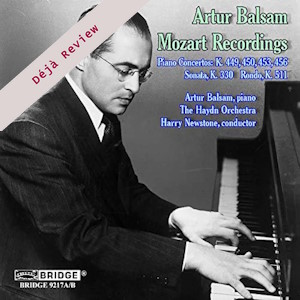
Déjà Review: this review was first published in May 2007 and the recording is still available.
Wolfgang Amadeus Mozart (1756-1791)
Piano Concerto No.14 in E flat major K449 (1784)
Piano Concerto No.15 in B flat major K450 (1784)
Piano Concerto No.17 in G major K453 (1784)
Piano Concerto No.18 in B flat major K456 (1784)
Rondo in A minor K511 (1787)
Sonata in C major K330 (1779)
Artur Balsam (piano)
The Haydn Orchestra/Harry Newstone
rec. BBC broadcasts June 1956 (concertos); Concert Hall LP c1951-54 (Sonata), live, February 1980, Manhattan School of Music (Rondo)
Bridge 9217 [2 CDs: 134]
Artur Balsam gave a series of broadcast performances of Mozart Concertos with Harry Newstone and The Haydn Orchestra in London in June 1956. Here we have four of them in preserved off-air tapes. I was delighted to read in Bridge’s booklet notes that Newstone left behind over four hundred such tapes, many with this orchestra that he directed for so many years. Amongst them were performances of over fifty Haydn symphonies – and since Newstone was such a perceptive conductor of the composer whose name he took for his orchestra we can but hope that Bridge will give us some fruits from this vast archive.
Firstly though we have the collaboration between Balsam – better known as an elite accompanist – and Newstone. The sound is somewhat muffly and that does affect dynamic range – though fortunately not so much in Balsam’s case. As with the last concerto release documenting Balsam on Bridge 9196 (Mozart, Beethoven, Hummel, C.P.E. Bach – see review) – we find the pianist to be a soloist of discretion, sensitivity, dynamism and refinement.
He is quoted as having said that his Mozart sees no “pronounced, startling contrast between a full piano and a relaxed, full but singing forte.” Indeed what his performances demonstrate is the validity and truthfulness of his belief. He plays with rhythmic buoyancy and immediately established a sensitive rapport with Newstone. Balsam’s credentials as a chamber partner are surely also very much to the fore – how he voices in response to wind statements for example, or his control of dynamics when picking up on orchestral paragraphs. The B flat major has a warmly moulded slow movement and excellent animation in the outer ones but better still is the G major. There’s command and elegance from Balsam and some terrifically clear passagework in the Allegro. The seriousness of the slow movement is never inert and Balsam’s precision over articulation is laudable. So too is the light-heartedness of the finale which has a proper infusion of vitality from all the forces.
The second disc houses the E flat major concerto, a performance broadcast on the same occasion as the B flat major, 14 June 1956. Despite Balsam being rather over-recorded in relation to the orchestra this is still another fine example of interplay and exchange between soloist and conductor. As so often the slow movement proves the centre of gravity with Newstone’s elegant but never manicured tapestry adding considerably to the success of the collaboration. Not unsurprisingly he was admired by such other players as Lili Kraus and Charles Rosen. Admirable too is the projection of the stormy contours of the slow movement of the B flat major.
There are two solo performances. There’s an undated Concert Hall LP of the C major sonata K330, an unobtrusively enjoyable and excellent performance – witty, playful, and paying due account to the depth of the slow movement. And finally there’s a powerful and much later 1980 performance of the Rondo in A minor, which was given at the Manhattan School of Music in 1980 and which is making its first appearance here.
This is excellent retrieval work from Bridge, whose commitment to Balsam has been of long standing and great worth.
Jonathan Woolf
Buying this recording via a link below generates revenue for MWI, which helps the site remain free


















